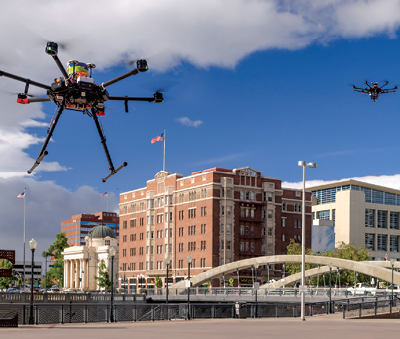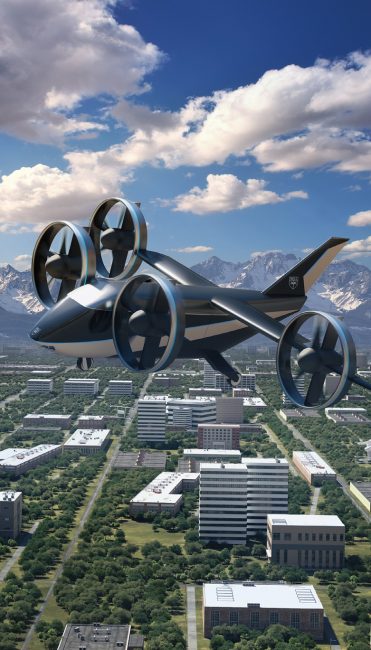
Next-generation VTOL concepts are rising to meet the future needs of a modern-day battlefield.
Vertical take-off and landing (VTOL) concepts for unmanned aerial systems (UAS) certainly aren’t new. Their reconnaissance and intelligence-gathering roles date back to the 1950s, and there’s been a gradual path toward technological advancements in the decades since.
But one need look no further than the infamous vertical and/or short takeoff and landing (V/STOL) Wheel of Misfortune —which visually depicts the many concepts that have stumbled or failed over the years—to see the challenge.
That said, the potential advantages of next-generation VTOL drones for the modern-day battlefield are becoming increasingly attractive. UAS of this type are a dream for a mobile military, reducing fixed-wing launch and recovery challenges while freeing troops from stationary runway constraints.
Additionally, emerging mission objectives across the various service branches underscore the need for low-footprint solutions that reduce weight and cost while increasing performance and safety. The Army’s desire for better acoustics and runway independence when replacing its RQ-7 Shadow tactical UAS, the U.S. Air Force’s exploration of resupply solutions and the Pentagon’s plans to leverage commercial R&D in the VTOL space are just some indicators around implementing the airframe in the defense space like never before.
Simply put, while the challenges of the past remain, there are indications that revolutionary new designs in development today have the potential to fulfill missions in ways traditional airframes simply can’t. What’s more, it’s sparking an unprecedented era of collaboration and innovation.
Drone companies and manufacturers alike are working across industries to rapidly accelerate their VTOL systems for military and even civilian applications—not just to meet the needs of the combat missions of the future, but also the needs of the world at large.
VTOL ADVANTAGES AND DISADVANTAGES
One individual keeping a close eye on VTOL trends within the military space is David Arterburn, a UAS expert and director of the Rotorcraft System Engineering and Simulation Center at the University of Alabama, Huntsville.
As a retired Army aviator who’s spent years conducting flight tests on automated approaches such as fly by wire, Arterburn can quickly run through a checklist of VTOL airframe advantages: they’re flexible and more maneuverable than fixed-wing aircraft, require less space to launch and recover, are runway independent and lower the overall cost of operations, to name a few.
The advantages of vertical lift, however, can be offset by some key challenges, such as poor efficiency, payload limitations and low endurance. VTOL systems use rotors to generate lift and thrust, requiring more power compared to fixed-wing aircraft, which only require a propulsion system, as lift is generated by its wings.
“The most efficient vertical landing platform is a single rotor helicopter, but that’s also the most fragile system because one defect in that rotor can become a catastrophic failure,” Arterburn noted. “That said, we’re seeing designs in the future vertical lift community to make VTOL more capable than it’s ever been.”
Whether these designs can meet their reliability targets to guarantee safety, and whether the battery technology will be enough to achieve ranges and affordability targets are still open questions, he explained.
But Arterburn believes a surge in urban air mobility efforts and the emergence of hundreds of proposed air taxi designs are really starting to push the envelope with respect to VTOL due to their need to be both quiet and efficient with a reasonable amount of range and capacity.
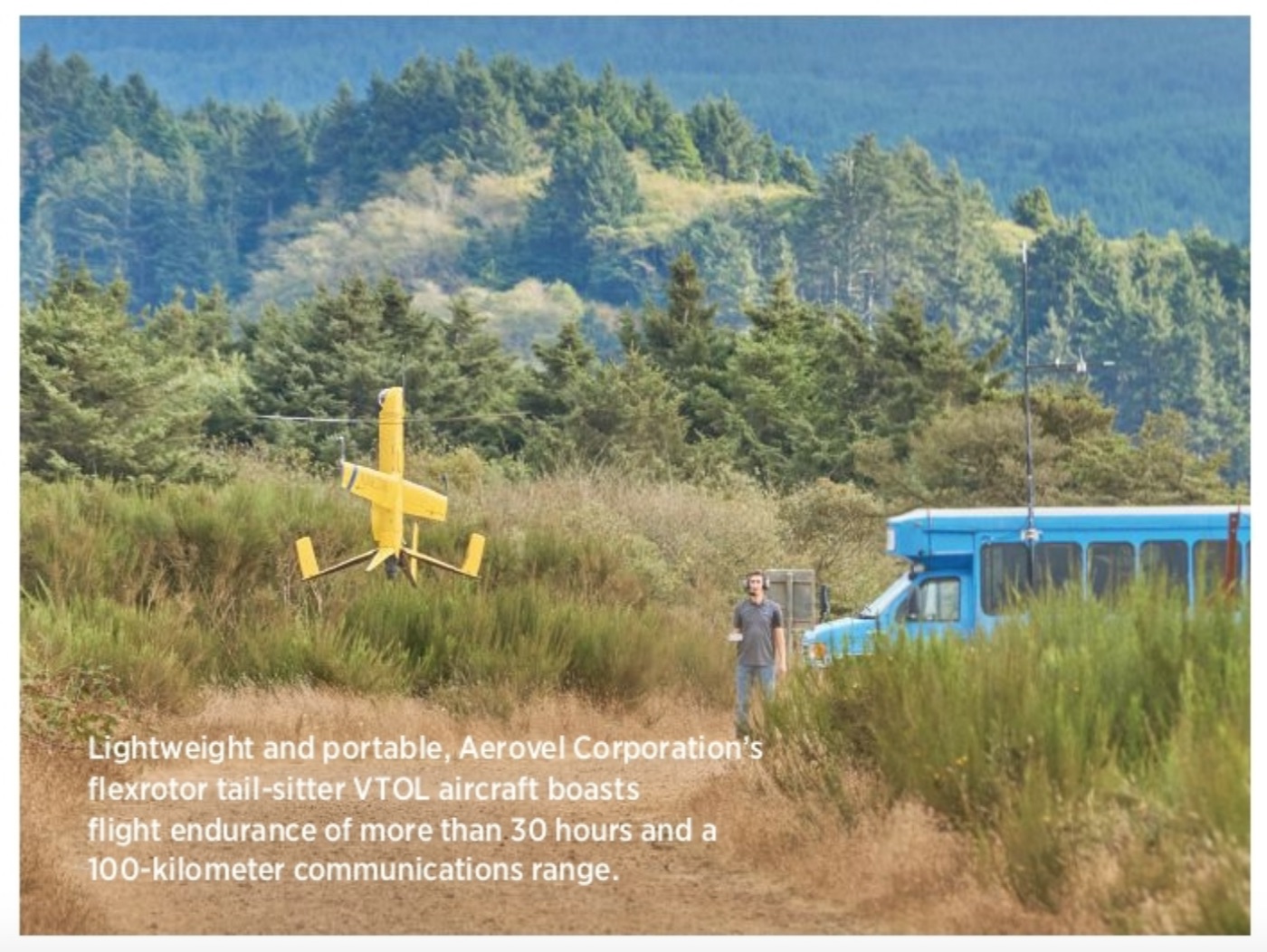
It’s also resulting in an unprecedented interplay between defense and commercial industries.
“If you look back at the early 1950s and ’60s, the military and NASA would build first and the commercial industry would then commercialize different defense technologies. Now it’s happening very much in reverse,” he said.
“Vertical lift is going to evolve at all scales into a more capable force as the need for runways and fixed operations diminishes, and we’ll be able to operate from remote sites more effectively and for longer periods of time. A lot of that’s just evolving and it’s becoming very interesting to watch.”
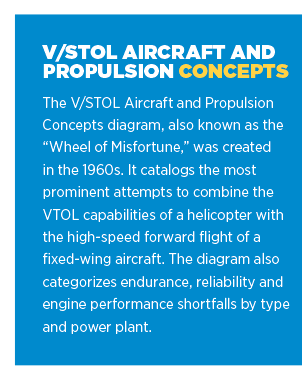
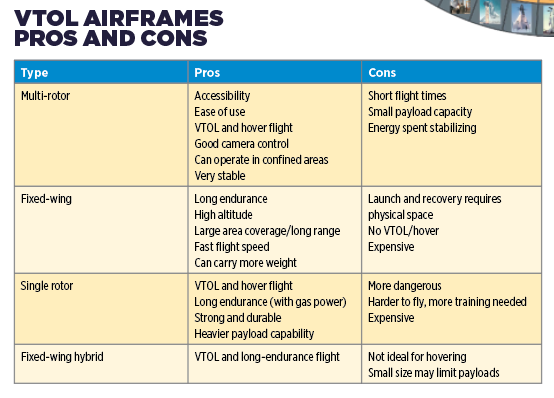
ENABLING ENDURANCE
Aeronautical engineer Tad McGeer is also well-acquainted with the VTOL Wheel of Misfortune, and he’s spent much of his career identifying technological solutions to UAS challenges.
McGeer was the founder of Insitu, now a Boeing subsidiary headquartered in Bingen, Washington, and is credited with developing ScanEagle, a small, long-endurance fixed-wing reconnaissance platform. He’s now founder and president of Aerovel Corporation in Cook, Washington, which has developed another unique design: a miniature flexrotor tail-sitter called Actaea.
“If you asked me 40 years ago if I’d ever work in VTOL, I’d have said ‘nonsense’ because the penalties associated with it are usually so large you don’t get a very useful aircraft in the end,” he explained. “That said, I’ve learned the tail-sitter arrangement gives you the smallest penalty. It uses the same power for all phases of flight and you can make the disk [rotor] loading very low, which is essential for cruise performance.”
Long range and endurance are capabilities not often associated with VTOL aircraft, but Actaea set an endurance record in 2017, flying for just over 32 hours. It was designed for maritime and land-based operations, and combines the best of endurance, expeditionary capabilities and economics in one state-of-the-art system.
“While the penalties for VTOL remain—there’s no getting around it—Actaea is small enough that you have a pretty useful aircraft in the end,” he said. “For anyone, especially the military, not having a lot of stuff to carry around is a good thing. But you have to do it in such a way that you’re getting reasonable performance. With a flexrotor tail-sitter you get that.”
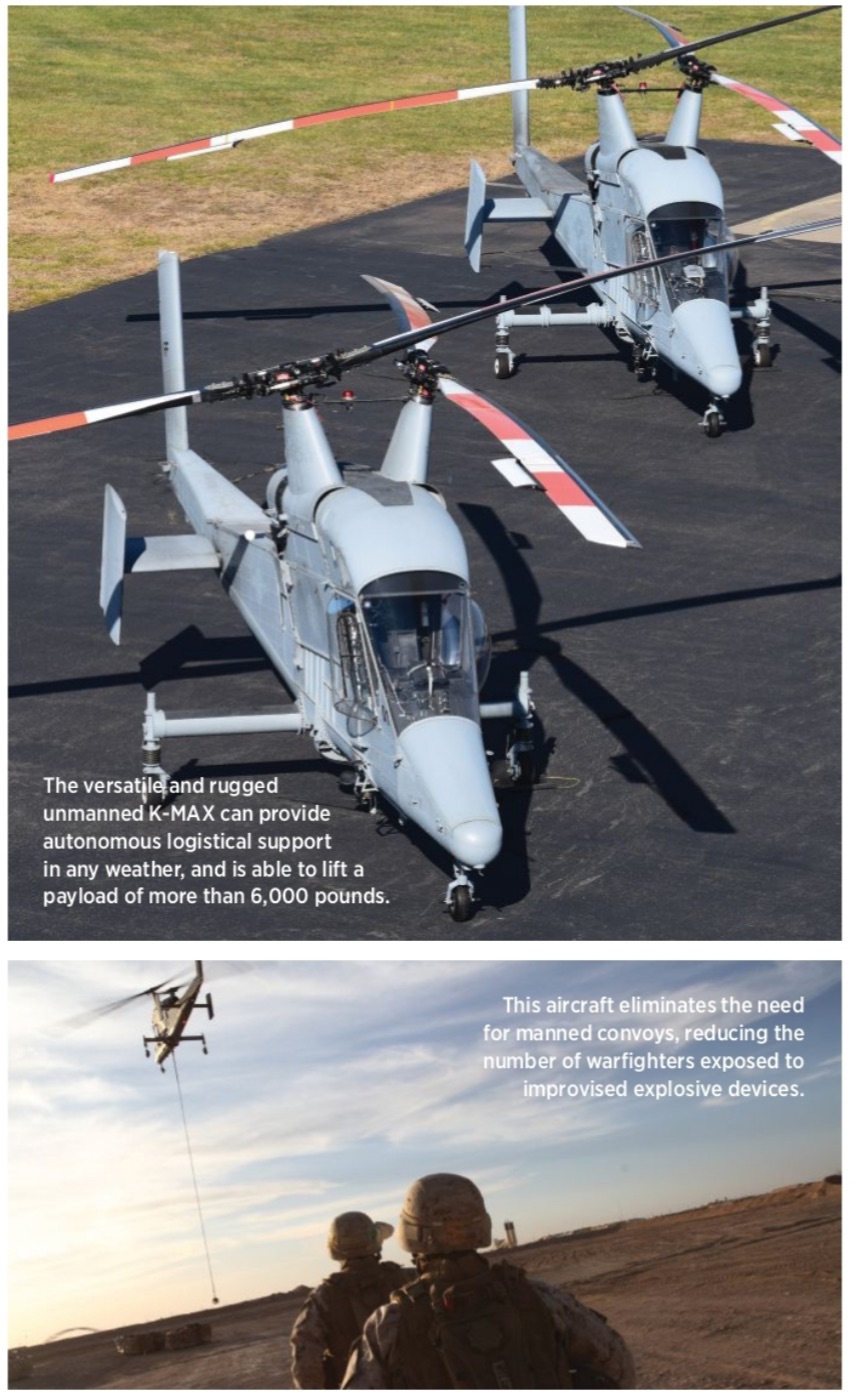
THE RELIABILITY OF ROTOR DESIGN
Another company addressing VTOL challenges is Bloomfield, Connecticut-based Kaman Aerospace Group. The company’s long history of making unmanned helicopters dates back to 1957.
Today, the team is developing its next-gen Kaman K-MAX helicopter, which offers a UAS that will be available this summer as a kit for both new production and existing aircraft. The vehicle will be able to resupply troops in austere environments or deliver critical supplies.
It’s clear that Kaman’s senior director of business development for the UAV Division of Government, Romin Dasmalchi, is thrilled to be a part of VTOL development at such an invigorating time. But he’s vigilant about shying away from extravagant concepts that miss the mark.
“On one hand, there’s all this buzz about eVTOL and battery-powered vehicles moving people via urban mobility, with the potential to disrupt the WW II model for supply chain, and that’s very exciting because there hasn’t been any change for so long,” he said. “On the other hand, we need to look at it with a very pragmatic eye.”
As a retired Marine aviator, Dasmalchi believes that taking a basic, reliable, heavy-lift airframe and equipping it with affordable, state-of-the-art technology is a practical way to do work with an unmanned system in the near future.
“Military customers want new technology and are very forward looking, but they also need systems that are not going to break and are ready to go,” he said. “The K-MAX’s intermeshing rotor design means that every bit of power you generate goes toward external lift, and that’s a key advantage.”
Dasmalchi underscores that as the Marine Corps issues planning guidance for future operating concepts, it’s calling for more autonomous systems and unmanned vehicles, and that’s all about connecting an increasingly mobile military.
“The future will require all sizes of unmanned vehicles to deliver anything from a small package of food, water or medical supplies all the way up to the larger payloads like pallets of ammunition or fuel for our next generation of fighters. If the idea is to keep everything distributed to make it more survivable, you have to invest in the systems that can keep them connected.”
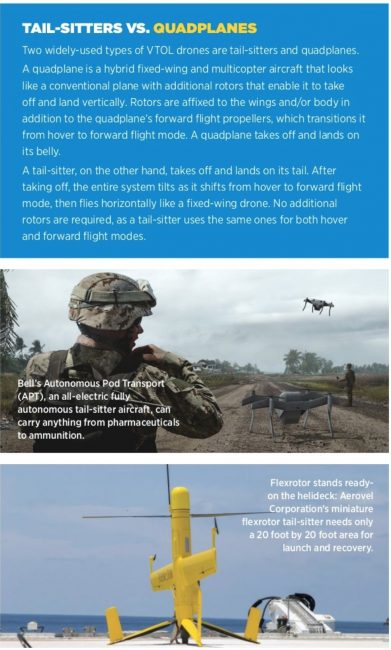
PARTNERSHIPS AND PORTABILITY
David Sharpin is the CEO of Los Angeles-based Auterion Government Solutions Inc, an open-source drone software company. With more than 30 years of experience in enterprise and government manned aircraft and unmanned aerial systems and robotics, he is well-versed in the UAS fixed-wing platforms of the past.
“For a number of years fixed-wing platforms were very effective, but more and more the requirements depict that soldiers don’t want to carry any launch and recovery equipment with them,” Sharpin said. “They want to be able to launch and recover from confined spaces, and without the need for advanced pilot experience—and that’s when people started to get more creative with VTOL concepts.”
One of those creative solutions can be found in Auterion’s recently announced partnership with Quantum-Systems, a company that develops and produces automatic transition aircraft.
By integrating Auterion’s cutting-edge open source operating system with Quantum-Systems’ hardware, they’ve developed a unique hybrid multicopter/fixed-wing VTOL solution designed for the dynamic environments in which military and security forces operate.
This new UAS comes in the form of Vector and Scorpion, a two-in-one portable rucksack system that’s fully compatible with the U.S. Department of Defense’s Group 1 UAS Architecture.
The Vector and Scorpion feature a modular construction with a configurable base fuselage. Scorpion is a tricopter UAS best suited for gathering intelligence, surveillance and reconnaissance (ISR), and can be fitted with an optional tethering system to enable 24/7 operations. By simply adding fixed wings and a tail section to the base fuselage, Scorpion can be transformed into Vector, an energy-efficient, fixed-wing VTOL for longer-range, longer-endurance ISR missions.
“Everything is a kit that you can put together in the field without any tools, and it can be assembled and ready to launch in under five minutes,” he said. “That’s important for soldiers in the field today and into the future.”
(For another system featuring ease of use in the field, see this issue’s “Project Watch” coverage of AeroVironment’s Quantix Recon.)
THE TRIED AND TRUE TILTROTOR
John Wittmaak works at Bell Flight in Fort Worth as UAS program manager for the team that designs and develops small to medium unmanned systems in response to government interest.
When asked about general advantages and disadvantages of VTOL aircraft, his response was simple: “We don’t believe there are any disadvantages. Everything we do is VTOL-capable.”
Bell boasts a long history in the space: it built the first mass-produced tiltrotor, the multi-mission V-22 Osprey, which the Navy has adopted for carrier onboard delivery, and it’s now scaling down that technology in the smaller next-generation V-280 Valor, a top contender to replace the Army’s UH-60 Black Hawk medium-lift helicopter, and the smaller V-247 Vigilant, a proposed ship-launched scout drone for the Marines.
“If you look across those products, they can all take off vertically and transition into wingborne flight,” he said. “The second thing they have in common is autonomy. These aircraft are extremely capable and, in many cases, can fly themselves.”
Wittmaak is responsible for several projects in the VTOL space, including the Autonomous Pod Transport (APT), an all-electric fully autonomous tail-sitter that is scalable and can be used for logistics. The company is currently flying prototypes, which can carry anything from pharmaceuticals to ammunition.
“Logistics has been largely ignored for a while, but you’re starting to see a lot of interest there now in the military,” he said. “VTOL is also seeing an increase in demand for two reasons: the reduced cost you get from electric vehicles is very attractive, and there’s a lot of interest in smaller aircraft.”
Bell is also developing Nexus, a hybrid electric air taxi that could fly four passengers (plus a pilot) up to 60 miles—and do so quietly using a hybrid or all-electric engine that opens up opportunities for military applications.
Wittmaak believes that as the military’s focus shifts toward the use of more platforms (starting at smaller scales and gradually getting larger) they are going to be all- electric and with higher levels of autonomy.
“I think we’ll start to see aircraft that can go out and complete missions on their own, regardless of what they encounter along the way,” he predicted. “As both air and ground vehicles increase their own capabilities, it then becomes about how to seamlessly integrate them across products and ground stations so that they can interact with one another.”
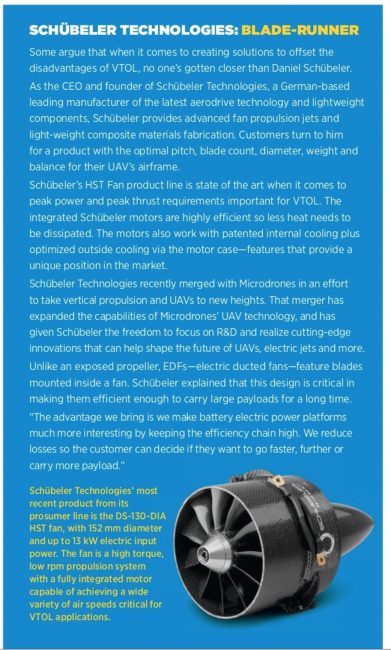
FOCUSED ON THE FUTURE
In 2018, as military operations of the future continued to call on industry to develop ever-more-efficient platforms, the United States Army established the Army Futures Command, which now has reached full operational capability and is headquartered in Austin, Texas. Its focus is modernization and speeding up the acquisition of platforms and technology centered on forthcoming needs.
As part of its “what’s next” approach, Lieutenant Colonel Ellis Smith leads the modernization effort of future unmanned aircraft systems for Army Futures Command. Vertical lift is a key priority.
“VTOL capability is going to be a really big advantage for the soldier in the future so that they’re not relying on systems that are tied to an airfield,” Smith said. “Operationally, runway independence really changes the predictability of where we’re going to deploy these systems from. When you bring in VTOL, you no longer have to worry about some of the constraints that put our soldiers in harm’s way.”
At the end of the day, however, Smith noted, the proofs of concept being developed will be left up to the individuals whose lives are on the line in the field.
“Nobody knows what our soldiers are going to figure out until we put those systems in their hands,” he said. “I’m really curious to find out the things they wish they could do with them or improve. There’s no one more creative than the soldiers employing these things and for me, their feedback will be the real eye-opener.”



